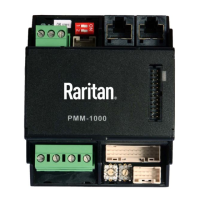
Do you have a question about the Raritan PMC-1000 and is the answer not in the manual?
| Brand | Raritan |
|---|---|
| Model | PMC-1000 |
| Category | Measuring Instruments |
| Language | English |
Lists the different BCM2 hardware and PM series models.
Provides instructions for physically installing the BCM2 and PM series hardware.
Details how to access the BCM2 via its web interface and perform initial setup.
Explains how to navigate and use the BCM2's front panel LCD display.
Describes how to connect Raritan environmental sensor packages like DPX, DPX2, DPX3, and DX series.
Explains how to track IT devices in a rack using asset management strips and tags.
Details how to connect a webcam to the BCM2 for viewing live images or snapshots.
Outlines the process for connecting supported Cinterion® GSM modems to send SMS messages.
Explains how to use an analog modem for remote CLI access when LAN access is unavailable.
Describes how to connect an external beeper for audio alarms and create event rules for it.
Details how to connect and administer Schroff® heat exchangers via the BCM2.
Guides on connecting the BCM2 to a wireless network using a USB Wi-Fi adapter.
Lists the web browsers compatible with the BCM2 web interface for optimal operation.
Provides steps for changing user passwords, including administrator privileges.
Explains the four main areas of the BCM2 web interface and basic operation.
Details how to view the Dashboard page, providing an overview of the BCM2 device's status.
Explains how to access and view details or edit settings for the PMC controller.
Guides on viewing and managing connected panels and power meters, including scanning for unconfigured ones.
Describes how to view information for connected environmental sensors and actuators.
Details the devices supported for connection to the FEATURE port.
Covers user accounts, permissions, and preferred measurement units on a per-user basis.
Explains how to define user roles and assign permissions for performing operations.
Guides on configuring network, security, date/time, event rules, and other device-related settings.
Covers device information, firmware updates, backups, network diagnostics, and unit resets.
Explains how to configure webcams and view live images or snapshots.
Details how to enable SNMP protocols for communication with an SNMP manager.
Explains the necessity of downloading the SNMP MIB file for using the BCM2 with an SNMP manager.
Describes how the BCM2 receives SNMP get and set requests to retrieve information and configure settings.
Introduces the command line interface (CLI) for administering a BCM2 device and its basic management tasks.
Provides instructions for logging into the CLI via HyperTerminal, SSH, or Telnet.
Explains how to use the '?' key to list available CLI commands or parameters.
Guides on how to query available commands or parameters for a specific CLI command.
Details how to use 'show' commands to view current settings or status of the BCM2 device.
Explains how to use 'clear' commands to remove unnecessary data from the BCM2.
Covers configuring wired, wireless, and IP settings for the BCM2 via CLI.
Explains how to control mechanisms or systems connected via actuator channels using CLI commands.
Describes how to unblock users who are locked out from accessing the BCM2 from the local console.
Explains how to reset the BCM2 device to factory defaults or restart it using CLI commands.
Introduces diagnostic commands for troubleshooting network issues.
Explains how to retrieve previously typed commands from the connection session.
Guides on how to use Tab or Ctrl+i to automatically complete commands.
Describes how to properly log out of the CLI to prevent unauthorized access.
Details the procedure to reset the BCM2 to factory defaults using the physical reset button.
Explains how to reset the BCM2 to factory defaults using the Command Line Interface (CLI).
Outlines how to determine the user accounts and roles intended for BCM2 access.
Guides on creating user groups for BCM2 on the Active Directory server.
Details how to enable and set up LDAP authentication on the BCM2 device.
Explains how to create roles on the BCM2 that match user groups for authorization.
Explains how to retrieve User Group information after successful authentication.
Describes setting a registry entry to allow domain controllers to write to the schema.
Guides on creating new attributes for the rciusergroup class.
Details how to add attributes to the user class in the Active Directory Schema.
Explains how to update the schema cache by reloading the Active Directory Schema.
Guides on editing individual user attributes within the rciusergroup.
Explains the use of the RADIUS standard attribute "Filter-ID" for conveying group membership (roles).
Details the properties required when using a RADIUS vendor-specific attribute (VSA).
Outlines necessary Microsoft Active Directory (AD) configurations for RADIUS authentication.
Specifies requirements for RJ45-to-DB9 adapter/cable for modem connections.
Guides on reserving IP addresses for BCM2 network interfaces in Windows DHCP servers.
Explains the threshold settings for a numeric sensor, including critical and warning levels.
Provides a table showing the relationship between different altitudes and correction factors for differential air pressure sensors.
Indicates available ways to query existing user accounts on the BCM2.
Provides information about accessing Raritan's free training materials.
Explains the importance of DNS server settings for mapping domain names to IP addresses.
Guides on installing the required USB-to-serial driver for Windows operating systems.
Describes the initial network configuration process using a serial RS-232 or USB connection via CLI.
Lists device-specific information that is not included in bulk configuration files.
Explains the concept of a certificate chain and its importance for TLS server trust.